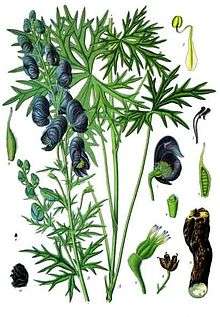Aconitum ferox
| Indian Aconite | |
|---|---|
 | |
| Aconitum ferox | |
| Scientific classification | |
| Kingdom: | Plantae |
| (unranked): | Angiosperms |
| (unranked): | Eudicots |
| Order: | Ranunculales |
| Family: | Ranunculaceae |
| Genus: | Aconitum |
| Species: | A. ferox |
| Binomial name | |
| Aconitum ferox Wall. ex Ser. | |
Aconitum ferox (syn. A. virorum) is a member of the monkshood genus Aconitum of the Ranunculaceae. The common name by which it is most often known in English is Indian Aconite. The plant grows abundantly at Sandakphu, which is the highest point of the Darjeeling Hills in the Indian State of West Bengal.
A tuberous-rooted, herbaceous perennial reaching 1.0 metre tall by 0.5 metres wide and tolerant of many soil types, Aconitum ferox forms the principal source of the Indian poison known variously as bikh, bish, and nabee. It contains large quantities of the extremely toxic alkaloid pseudaconitine (also known as nepaline, after Nepal) and is considered to be the most poisonous plant found in the Himalaya and one of the most poisonous in the world.[1]
The symptoms of poisoning usually appear 45 minutes to an hour after the consumption of a toxic dose and consist of numbness of the mouth and throat and vomiting. Respiration slows and blood pressure synchronously falls to within 30-40 beats per minute and consciousness characteristically remains unclouded until the end, which consists usually of death by asphyxiation, although occasionally of death due to cardiac arrest. [2]
Monier-Williams lists it as one of the definitions of <bhRGga> or Bhringa.
Use as a (potentially lethal) Aghori Entheogen
Aghori, left-hand path, tantric, Shaivites (devotees of the Hindu deity Shiva) smoke the dried roots of Aconitum ferox, combined in a mixture with cannabis flowers, in a practice that is part consciousness-expansion by entheogen, part ordeal by poison. Aghoris, no strangers to the use of all manner of dangerous drugs (such as Datura metel), warn of the extreme danger posed by smoking mixtures containing aconite, and restrict their use to the most experienced adepts of their particular school of Shaivism, as being potentially lethal.[3] Drug-induced, altered states of consciousness comprise at least three elements : the effects of the drug upon the brain and body, set and setting. Given that Aghori tantrics are charnel ground ascetics who pursue moksha (spiritual liberation) in settings of extreme horror,[4]venerate wrathful deities (principally Bhairava, his consort Bhairavi, Dhumavati and Bagalamukhi) and find in Aconitum ferox a drug with unpleasant somatic effects warning (rightly) of possible death, it is clear that the experience evoked by the smoking of Aconite in such circumstances is likely to be one of dysphoria (albeit dysphoria sought consciously, in pursuit of the deeper euphoria of advaita or realisation of the oneness of all being).[5][6][7]
Lakhvir Singh murder case
The use of A. ferox as a criminal poison recently gained notoriety in the U.K. as a result of the murder trial of a Ms. Lakhvir Singh, a Sikh woman from Southall (a suburban district of the London Borough of Ealing). Ms.Singh was found guilty of the murder of her ex-lover, 'Lucky' Lakhvinder Cheema and the attempted murder of his fiancée, Gurjeet Choongh with a curry spiked with bikh poison acquired from India. After consuming the poisoned curry, the unfortunate Mr. Cheema began to vomit and over the course of the next hour suffered total paralysis of all four limbs, blindness, a drastic fall in blood pressure and heart failure, leading to his death within an hour of his admission to hospital. Ms. Choongh was more fortunate, having consumed less of the lethal dish, and later recovered, after having been placed in an induced coma.[8]
References
- ↑ http://www.herbcyclopedia.com/item/aconitum-ferox-the-strongest-poisonous-plant-2
- ↑ Curry poisoning woman found guilty of murder, BBC News 2010-02-10
- ↑ The Encyclopedia of Psychoactive Plants : Ethnopharmacology and its Applications, Rätsch,Christian, pub. Park Street Press U.S.A. 2005
- ↑ Indian doc. focuses on Hindu cannibal sect http://www.today.com/id/9842124#.UsLVWdIW1A0
- ↑ http://www.varanasi-ganges.com/aghori.html Aghori, Varanasi, accessdate = 14-5-2016
- ↑ Barrett, Ron (2008). Aghor medicine: pollution, death, and healing in northern India. Edition: illustrated. University of California Press. ISBN 0-520-25218-7, ISBN 978-0-520-25218-9.
- ↑ Svoboda, Robert (1986). Aghora: At the Left Hand of God. Brotherhood of Life. ISBN 0-914732-21-8.
- ↑ http://news.bbc.co.uk/1/hi/england/london/8444245.stm